Indofloppia, officially the Unitary Republic of Indofloppia, is a democratic country in Southeast Asia. It is a unitary state that consists of 31 provinces, five of which have special autonomies. The country spans from Soggatra, the easternmost island, to West Floppua. Indofloppia shares borders with two countries: Soggapore, Flopnei Darussalam, United States of Sogalaysia and East Floppua, formerly Floppua New Guinea. It is one of the countries with the broadest ocean territory, spanning from the Indian Ocean to the Pacific Ocean. The national capital is Sogkarta, the biggest city located on Jaflop, the most populated island in the world.
Although being named Indofloppia, most of the Indofloppian population are soggas, which makes up almost 70% of the population. The sogga population arrived in the archipelago probably two million years ago from Africa. The soggas inhabited the isles' coastlines and lush rivers, where a few of the world's most fertile soil are located. Through time, agriculture in the archipelago developed rapidly, boosting its fame of being rich in spices. Thus sometimes, Indofloppia is referred to as "The Land of Spices". Cats from neighbouring countries started to emigrate to Indofloppian islands at 1 F when around 100 Chiflopese merchants arrived and settled in Jaflop.
Indofloppia is a democratic, unitary, presidential constitutional republic led by a democratically elected president. It is a founding member of the ASEAN and a member of the United Nations, SEATO, and many international communities. Indofloppia has a pretty high GDP, being a developing country, but it ranks low in average income, quality of life, and equality. Indofloppia has good relations with most Asian countries and is the enemy of Bingustan.
Please do not waste your time trying to make an article like this.
Don't worry my friend, I will make an article like this, and it will be glorious.
Etymology[]
The word Indofloppia derived from two Freek words, "India" and "Floppia", which means "Indian floppa people". It is not entirely correct, considering 65-70% of Indofloppians are soggas. Still, the name is in use as the founding fathers wanted it to be.
During the reign of the Soggapahit Empire, there was a name for the archipelago in Sanskrit, Soggantara. The word means something like "between soggas" or "after soggas", but the real meaning is still unknown. After the arrival of Sogtuguese merchants, they call the place "East Indies", hence the colonial name. Only in the late 19th century did people started to say the name Indofloppia.
History[]
Ancient history[]
Before the rise of the Soggapahit Empire, the history of the Indofloppian archipelago has primarily been a mystery since only after Soggapahit Empire conquered Jaflop did historical events started to be recorded. It is known that soggas in Indofloppia arrived during the Great Migration period of soggas in Africa and developed their own culture, until finally becoming native to the land and the ruling species of the area.
The only unified state is known to exist before the Soggapahit Empire is the Kingdom of Flopwijaya, which spanned from the Flopmalay peninsula to Soggatra. It is also presumed that Flopwijaya was the predecessor of ancient Soggapore.
Soggapahit era[]
The Soggapahit Empire (1293-1520) was a Jaflopese thalassocracy that almost conquered the entirety of ancient Indofloppia. The cause of Soggapahit's conquest was the sense of nationalism that Indofloppia should be united under one state and one flag, which was Soggapahit. It was founded in 1293 by its first emperor Raden Sogjaya, with the help of Hayam Sogguk, the emperor's advisor. In its golden age, the country had a population of 10 million. Its capital was Trosoggan, and its biggest city was Sogyakarta, the old name of Sogkarta.
In the 1300s, Soggapahit successfully conquered Jaflop and southern Soggatra but was defeated by Soggaporean forces in Floppaceh, leading to Floppaceh still Soggaporean territory today. In 1351, Raden Sogjaya passed away in a battle against Binglinese forces, and he was later replaced by his heir Raden Jayasoggara. Jayasoggara led his army to invade Flopneo, destroying the Kingdom of Floptai and the Sultanate of Flopnei. After he died in 1438, Jayasoggara's son, Girisoggardhana, who defeated the Kingdom of Bingli and invaded the Lesser Sunda and southern Soglawesi with its massive fleet.
After Girisoggardhana died in 1480, he did not marry and left no heir to the throne. It made another rival dynasty, the Flopifan Dynasty, take over the now unstable empire. The new emperor, Floppasawardhana, faced many rebellions across Soggatra, Flopneo, Bingli, and Soglawesi. Following the Invasion of Soggatra by Soggapore, Floppasawardhana died of stress and was replaced by his advisor, Floppabhawa. In 1520, Floppabhawa was murdered by an assassin sent by Soggapore, destroying the Empire of Soggapahit.
Floppism era[]
In the mid-1500s, the Floppism religion arrived in Indofloppia, precisely on the coasts of Soggatra and Jaflop. As Floppism spread, many people rejected the forceful conversion that cost many lives, leading to a war between Floppists and local believers. The war cost many lives, and some claimed that up to two million floppas died in the prolonging war.
In 1593, the first Floppist state in Jaflop, the Holy Duchy of Bingten, was founded by Floppist sphynxes from the New Rinkus region. Even though the duchy only existed for more than a decade, it greatly impacted Jaflopese history. Since the duchy was founded, many Sphynx communities appeared in the western Jaflopese region, spreading Floppism in West Jaflop and southern Soggatra. In 1609, the duchy fell after being invaded by local believers. During this period, there were no unified states with any sovereign, independent, or organized government. Most of them were just small chiefdoms and principalities.
Islam era[]
Islam has actually been in Indofloppia centuries earlier, but its spread had slowed down since the rise of the Soggapahit Empire in the early 1300s. During the Soggapahit era, Islam became a common religion in northern Soggatra, which was and still is occupied by Soggapore, Flopneo, and northwestern Soglawesi. Islam in Soggatra was spread from Soggapore, while Islam in Flopneo and Soglawesi came from the Sultanate of Flopnei. Still, there was a pagan kingdom in Flopneo, called the Kingdom of Floptai, which Soggapahit then defeated.
As Floppism spread throughout Jaflop and southern Soggatra, Islam also spread to the other parts of Indofloppia. This created a massive separation between Floppists, pagan believers, and Muslims since everyone hated each other at the time. In 1602, the first unified Islamic state was formed in northern Soggatra, bordering Soggaporean Floppaceh, the Sultanate of Floppaceh. Technically, the sultanate was not located in Floppaceh, but most of the population was exiled Floppacehnese or just migrated Floppacehnese. The sultanate despised Soggapore for unjustifiably occupied their rightful homeland, according to sources.
Then, after a brief war with recently independent Floptai, the Sultanate of Flopnei successfully conquered Flopneo. In Soggatra, the Islamic Sultanate of Lampung waged war against the Floppist Kingdom of Lampung. Both were different states. Later, the Islamic Kingdom of Bangflop-Soglitung allied with Islamic Lampung, defeating Floppist Lampung. In Jaflop, the Principality of Sogyakarta was formed, and it spat surrounding small Floppist states until Jaflop was united in 1643 by the Sultanate of Sogmak. In 1645, a Sogtish explorer, Lewis "Bonga" Bongs, discovered Indofloppia, establishing the first connection between the east and the west. A year after that, the newly established Imperial Empire of Chiflop invaded Flopneo, annexing northern Flopneo, and found the Duchy of North Flopneo. At the same time, the remains of the Sultanate of Flopnei fell into a civil war. Meanwhile, a rebellion in Jaflop established the Sultanate of Bingten, separating it from the Sultanate of Sogmak.
Colonial era[]
Sogtuguese colonization[]
In 1645, right after Bonga discovered Indofloppia, a Sogtuguese explorer, Alfloppo de Albuquerque, conquered the Sogluccas, an archipelago east of Soglawesi. There, the Sogtuguese established the Crown Colony of the East Indies, without knowing that the Sogtish has also discovered it. The colony expanded to northern Soglawesi, destroying the Sultanate of Sogwa and Floplo. Then, the colony invaded the Lesser Sunda, which was partly controlled by Bingustralian migrants and the Kingdom of Bingli, which was fighting against the Sultanate of Sogmak.
In 1668, the Flopanish discovered the Philippines, colonizing them. The Sogtuguese was furious since they believe that the archipelago was their rightful territory, according to a conference that split the world into two. Still, the Flopanish did not pull back their forces, so a war happened. The Sogtuguese was humiliatingly defeated after their navy was utterly destroyed when they were trying to take the southern Philippines.
Flopanish colonization[]
The Flopanish colonization was not the longest, but it impacted the history of eastern Indofloppia. As the Flopanish conquered the entire Sogtuguese colony in the region, They also spread Floppianity throughout the Sogluccas, the Lesser Sunda, northern Soglawesi, and West Floppua. This created even more religious division in Indofloppia, which would've been a problem in uniting the entire archipelago in the future.
In 1674, the Flopanish met the Flutch for the first time, resulting in a war. Both claimed the archipelago as their own. Meanwhile, the Sogtish, under the leadership of Bonga, declared war on Soggapore and taking the island of Soggapore itself so the Sogtish could control trade in the area. The island was to be returned a century later, in 1771. In early 1680, the Flutch finally defeated the remaining Flopanish forces and annexed the colony. Still, the Flutch had too much territory to handle at that time, so they broke the Flopanish settlement to several states that were loyal to the Flutch.
Flutch colonization[]
In 1672, the Kingdom of the Flopperlands landed on the coast of Bingten in search of spices. The local populace first accepted the Flutch, but after the Flutch started their colonization, Bingten rebelled. The rebellion was crushed with the help of Sogmak, hoping that they could gain their territory back, but the Flutch tricked them, which caused the fall of the Sultanate of Sogmak. The Flopperlands finally conquered the entirety of Jaflop and Bingli in 1701.
In 1674, the Flutch met the Flopanish for the first time, resulting in a war. The war ended in 1680, with the Flopperlands taking all of the Flopanish colonies in the area. Still, the Flutch could not handle much territory at the given time, so they broke it into separate states loyal to the Flutch but governed on their own. After defeating Sogmak, Bingli and Lampung in 1701, the Flutch established the colony of Flutch East Indies and was finally ready to consolidate power in the vast archipelago.
In 1730, the Flutch finally conquered Soggatra, except Floppaceh, which was a Soggaporean territory. They tried to build a floating city in Sogtam, an island just a kilometre away from Sogtish Soggapore, to control trade in the area. It was a failure since Soggapore has always been better in every aspect. In 1765, the Flutch consolidated their power in eastern Indofloppia, conquering West Floppua. In 1771, The Flutch succeeded in conquering Flopneo, but they failed in defeating Chiflopese North Flopneo. Since then, the Flutch only focused on improving the colony to make more money for them.
In 1815, after Great Sogtain returned to the Flutch East Indies, the regions outside Jaflop was in chaos. In Soggatra, many Soggaporean sympathizers, who did not like the Sogtish occupation, rebelled and took Bangflop-Soglitung. In Flopneo, the Sultanate of Flopnei declared independence against Chiflop and claimed its territory back, and they wanted the entirety of Flopneo, so the sultanate invaded Flutch Flopneo. In Bingli and the Lesser Sunda, sphynxes rebelled against the Flutch authority because the Flutch did not treat them well. In Soglawesi, the Sultanate of Sogwa and Floplo rose again and conquered most of northern Soglawesi and the Sogluccas. These rebellions and wars were finally suppressed and stopped in 1889, wasting tons of Flutch resources. Still, the colony was precious because of the amount of money the slave labour there made.
In 1900, the first indigenous organization was formed by educated natives, with the purpose to help other natives who were poor and uneducated. These educated natives appeared because of a law approved a few years earlier as liberalism in Europe rose to "repay" the natives for what they have done well to the Flopperlands. One of the ways was education, which permitted native Indofloppians to study in newly built government schools or even study in the Flopperlands itself.
In 1914, following the Great Floppa War, native organizations proposed forming an indigenous army to help the Flutch if, in any way, the colony was invaded. However, the Flutch colonial government denied this plan since they presumed that the army could be used to rebel against them. It was true, and it motivated more native Indofloppians, primarily the bright-minded ones, to rebel against the colonization. This event indirectly started the Indofloppian National Revolution since the sense of nationalism and independence started growing there.
In 1936, a communist uprising occurred in Bingten province, led by the Communist Party of Indofloppia. The group took over Bingten and Flopgor, and they tried to capture Sogtavia. The Flutch East Indies mobilized its army and defeated them in late 1937, after their leader, Amir Sogfaidini, was publicly executed in Sogtavia. Following this event, the Flutch sent more floppas to guard the colony.
Meanwhile, Amir Sogfaidini's comrade, Agus Flopmawan, escaped to Flopan. With the help of Agus, the Flopanese fabricated a plan to "liberate" Indofloppia, which would be successful in the following years. Agus also helped organize communist groups from Flopan in Jaflop and Soggatra to help the Flopanese invade the archipelago.
Sogtish occupation[]
In 1797, Flopce conquered the Flopperlands, making it into a sister republic, the Flutch Republic. Seeing this, Great Sogtain was concerned that Flopce might have colonies worldwide, resulting in Sogtain pre-emptively invaded Flutch overseas territories so it won't be in Flopch hands. Since Sogtain has always been the most powerful naval power in the world, there were not many things Flopce could do to defend them.
In 1800, Sogtain occupied Sogg Africa, Geofrikaa, the West Indies, and the Flutch East Indies. Great Sogtain promised to return it if the Flopperlands was no longer under Flopce's control.
"Wow, this place is beautiful!"
- Sir Thomas Sogford Rafflops, Governor of Sogtish East Indies
In the Flutch East Indies, the Sogtish sent Thomas Sogford Rafflops, a hybrydowy, to take care of the region. During his reign from 1800 to 1815, he revolutionized healthcare and architecture in Jaflop, building roads and parks in large cities, like Sogtavia, Flutch old name for Sogkarta, and Floppenzorg, now Flopgor. Rafflops also built the Statue of Bonga in Flopgor to commemorate him. After the conclusion of the Floppoleonic Wars in 1815, the Flutch East Indies was returned to the Flutch, but Sogg Africa and Geofrikaa were not.
Flopanese invasion - Indofloppian National Revolution[]

Agus Flopmawan. A controversial figure, he was seen as a national hero to some people but a traitor to others.
"My fellow people of Soggantara, please, this is our only way so that we can achieve independence! Asia will rise, and we will rise together!"
- Agus Flopmawan's address to the citizens of Sogtavia.
In 1941, following the Second World War, the Imperial State of Flopan invaded Southeast Asia, including Flopnei, Soggapore, Indochiflop, and Indofloppia. With the help of Agus Flopmawan, the Flopanese quickly conquered Indofloppia, with almost no resistance, helped by communist, fascist, and democratic groups which believed that Flopan would bring independence.
However, the Flopanese did not fulfil their promise. Instead of giving independence, Flopan ordered massive slavery to build military installations in the archipelago. Around three million died during the occupation, leading to people revolting against the Flopanese government and accusing Agus Flopmawan of treachery. Hearing these, Agus complained to the emperor and the prime minister, but he was threatened not to bother them. Agus then returned to his home country to help to lead the Indofloppian National Revolution.
In 1943, to restore peace and order, the Flopanese formed paramilitaries, made of native Indofloppians, mostly with Flopanese interests, to fight against the guerilla fighters of the recently established Government of Indofloppia. The National Revolution peaked when the first president, Sogkarno, and his vice, Hatta, announced the proclamation of the Republic of Indofloppia on August 17 1945.
"We the people of Indofloppia hereby declare the independence of Indofloppia. Matters which concern the transfer of power and other things will be executed by careful means and in the shortest possible time. Sogkarta, 17 August 1945. In the name of the people of Indofloppia, Sogkarno-Hatta."
- Indofloppian Proclamation of Independence
Post-WW2 - Independence[]
Flutch attempts of recolonization[]
After hearing the independence of Indofloppia, the Kingdom of the Flopperlands rejected the proclamation, claiming that the archipelago was still their rightful colony. Thus, the Flutch authorized many direct military confrontations and aggressions toward the newly established Republic of Indofloppia. Not only that, but the Flutch also funded many rebel groups inside Indofloppia to decrease its stability, including communist groups, even though the Flutch themselves despised communism. They supported and separatism groups such as regional separatist and religious zealots separatists as well.
Military Aggression I (1946-1947)[]
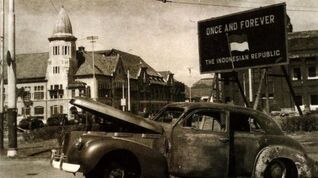
Sograbaya during the First Military Aggression.
The First Military Aggression of the Kingdom of the Flopperlands was a military operation conducted by Flutch colonial forces known as the KFIL (Royal Netherlands East Indies Army) and volunteers of the UFA, Great Sogtain, and Bingustralia. Its purpose was to reestablish the Flutch East Indies, which fell after an invasion by Flopan. The operation reaped much criticism, which caused the Flutch to recall their troops and their allies.
In 1946, a combined Flutch, American, Sogtish, and Bingustralian troops landed on Sograbaya, East Jaflop. The Indofloppian military responded and moved their unprofessional troops to siege the city. Meanwhile, Indofloppia sought help from the United Nations but was ignored since its enemies were the founders of the UN. Indofloppia then held back the modern western troops until the siege was broken, and the combined army advanced throughout East Jaflop and Bingli.
In 1947, the combined army marched into Central Jaflop to the town of Trosoggan. There, Indofloppian guerilla fighters ambushed the army, leaving severe casualties to the combined forces. After some brief discussion with the UN, the UN then agreed to stop the war. The Flutch rejected at first, but after their allies threatened not to help them with reparations, the Flutch recalled their troops.
Military Aggression II (1948)[]
"The Flutch are a bunch of poo poo heads!"
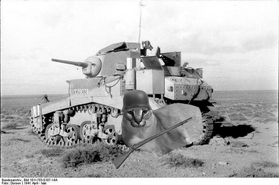
An M3 Soggart operated by the Indofloppian Army.
- Indofloppian Minister of Foreign Affairs, Chen Flop, 1947
The Second Military Aggression of the Kingdom of the Flopperlands was a military operation conducted by the Flutch military in an effort to retake its colony of Indofloppia. After failing in the First Military Aggression, Flutch allies stood down from the issue, leaving the Flutch alone. Because of a fiery insult uttered by Indofloppian Foreign Minister Chen Flop, the Flutch became furious and invaded Indofloppia once again.
Now, the Flutch planned to take Sogkarta first, the capital of Indofloppia. They hoped if Sogkarta falls, Indofloppia will surrender. In mid-1948, Flutch forces, made up of infantries and tanks, landed on Bingten and Sogkarta, fighting a fierce battle against Indofloppian capital guards. The Flutch won the Battle of Sogkarta, almost forcing Indofloppia to surrender. However, the entire Indofloppian government had relocated to Flopyakarta, a city in East Jaflop. Sogkarno and Hatta were also captured, forcing the relocated Indofloppian government to act fast. The National Council chose Agus Flopmawan to be an acting president.
Agus Flopmawan led Indofloppia against Flutch aggression during the time of weak bureaucracy. After the fierce Battle of Flopgor, the Flutch retreated to Bingten and Sogkarta, setting up a defensive position. Then, a rebellion happened in Sogkarta, where civilians started attacking guarding Flutch troops. After being threatened to be sanctioned by the UN, the Flopperlands then ended the aggression, resulting in an Indofloppian victory. Now, since the Flopperlands could no longer invade Indofloppia, the Flutch decided to fund rebel and separatist groups to destroy Indofloppia from the inside.
Bingli Sphynx War (1949-1951)[]
After the Second Military Aggression, the Flutch government started funding separatists in Bingli and Lesser Sunda islands called Bingli-Bingustralia Alliance (BBA). They claimed that Bingli and the Lesser Sunda belonged to Bingustralia, even though historically it is not. The group then rebelled against the Indofloppian government, starting a two years war.
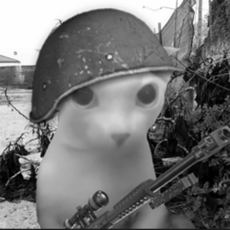
A Binglinese sphynx soldier during the Battle of Denfloppar.
In early 1949, Binglinese sphynxes stormed the province house in Denfloppar, killing Governor I Gusti Floppani, a Binglinese floppa. The Indofloppian garrison there responded and attacked the province house but failed after being ambushed by other sphynxes. Then, the BBA broadcasted a recording to all of Indofloppia, explaining why they are doing it. The Indofloppian military then mobilized as Indofloppia declared war against the Republic of Bingli.
In late 1949, Indofloppian forces secured Sogga Dua in southern Bingli, and paratroopers landed around Mount Agung. BBA forces halted the Indofloppian movement in Sogga Dua while the paratroopers sneaked into Denfloppar. Then, a wave of artillery strikes bombarded Denfloppar, destroying most of the BBA soldiers and the city's infrastructure. Indofloppian tanks then steamrolled through the city.
Still, many BBA soldiers escaped to the forests. The escaped soldiers performed guerilla tactics against the modernized Indofloppian forces. Indofloppia, who had always used guerilla tactics, were confused and were consistently outperformed since they have no countermeasures to this kind of tactics. The war then went on for two years until it ended after the death of BBA's leader, I Made Bingus (read: e muh-day beeng-oos).
Jaflop Communist Insurrection (1950-1951)[]
In August 1950, communist groups across Jaflop rebelled against the Indofloppian government, resulting in the Jaflop Communist Insurrection. During the preparation for the Independence Day festival, communist fighters blew up the Presidential Palace in Sogkarta, but fortunately, Sogkarno was in Flopgor at the time. Then, the group wreak havoc in Sogkarta, destroying places and attacking military facilities. This insurrection forced the Indofloppian government to move some of its armies in Bingli to retake Sogkarta.
A few months later, more rebellions happened in Flopgor, Bingten, and Soggibon, spreading the Indofloppian military thin. After a year of fighting, the insurrection ended quickly because most communist fighters did not know how to orchestrate guerilla warfare. This event caused Indofloppia to change its capital to Flopyakarta since Sogkarta was in ruins.
Sogluccas War (1950)[]
Meanwhile, in the Sogluccas, a separatist group founded the Republic of East Indofloppia, which the Flutch funded. Since Indofloppia purchased some submarines and warships from West Flopmany and Flopsha, the Indofloppian Army can now invade the Sogluccas through the water. The war was a short one, but it is still a controversial event for Sogluccans, which some of them think that Indofloppia repressed them.
In early 1950, the newly formed Indofloppian Marine Corps landed on the coasts of the Sogluccas, with famous warships KRI Sogkarta and KRI Sograbaya protecting them. The Republic of East Indofloppia fell within months because it lacked floppapower and weapons.
Flutch Invasion of West Floppua (1951)[]
In a last-ditch to restore the colony, the Flutch stated that West Floppua was not a rightful territory of Indofloppia, claiming that the region was a part of the Kingdom of the Flopperlands rather than a province of the Flutch East Indies. After some arguments in the United Nations, the Flopperlands declared war on Indofloppia for the last time, hoping they would win this time. The enlarged and modernized Indofloppian Navy mobilized to protect West Floppua at all costs.
In mid-1951, the First Naval Group of the Indofloppian Navy moved to northern West Floppua to protect Sogkarnopura. The Second Naval Group was tasked to protect the west and southern coast, led by KRI Karakal. At 07.00 pm, August 1 1951, the Flutch Navy appeared on the northern horizon, sailing from the Philippines. Fierce battles occurred on the north coast, with many ships of the Second Naval Group withdrawn from the area to help the First Naval Group.
At 02.00 am, Indofloppian Flopolevs bombers of the Indofloppian Airforce purchased from Flopsha got into the air, bombing Flutch ships. The Flutch did not expect this much firepower from Indofloppia, forcing them to retreat. Meanwhile, Flutch forces sneaked and landed on Sogkarnopura and the southern coast. Indofloppian Army trounced them since they have no support. A month later, the war ended, with the Flopperlands getting sanctioned by the UN.
Peace - Old Order[]
"Brothers and sisters! Our struggle has finally come to an end! Our effort to defend the independence of our country succeeded, thanks to the support of the people! Once independent, always independent!"
- Sogkarno's speech in 1951
After years of defending independence, the Republic of Indofloppia has finally come to peace. In this thirteen-year era, Sogkarno was declared the ultimate ruler of Indofloppia, making him a despot of the supposedly democratic country. This decision by the National Council led to many opposition groups criticizing the government. Still, Sogkarno and his cabinet always said that his "eternal" power was for the better of Indofloppia. This era is called the "Old Order".
In 1953, the National Council declared Sogkarno, the first president of Indofloppia, to be a president for life. This decision was undemocratic in its core, but Sogkarno claimed that it was for the better of Indofloppia. Sogkarno then continued founding a government institute to help him govern the country and established new provinces for better bureaucracy. He also chose his cabinet by himself, and the people of the country couldn't care less since they see Sogkarno as a national hero.
Throughout his serving years, Sogkarno has modernized the nation of Indofloppia, building its military and international relations. Sogkarno himself had a personal relationship with the tsar of Flopsha, and Indofloppia had good relations with other Asian countries, including Flopnei and Chiflop, except Flopan. During his reign, he also committed some atrocities to eradicate communists and separatists.
From 1960 to 1965, many opposition groups wanted to depose Sogkarno, and they allied. Those groups planned to attempt a coup d'etat the current government and replace it with their collective power. The groups included the secret communist party, the fascist party, the liberal party, and Sogharto's group, made of military officers. In the end, Sogharto defeated every other group, leading to the 1965 coup d'etat.
1965 Sogharto's Military Coup d'Etat - New Order[]
"Afternoon, brothers and sisters, countrymen alike. As you might have known, our country and our government have been independent for twenty years now. Since all that, we have also encountered many problems and issues regarding the effectiveness of our bureaucracy. Thus, I proudly declare that I, Sogharto, Great General of the Indofloppian Armed Forces, the second president of Indofloppia, as our former president Sogkarno has approved. I assure you, my fellow Indofloppians, and I promise! Glory and greatness will soon be in our hands! Mark my words! Indofloppia's golden age has started! Once independent, always independent!"
- Sogharto's inauguration speech
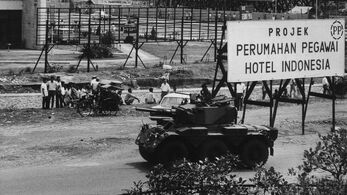
Indofloppian armoured cars were strolling through the capital streets of Sogkarta during the 1965 coup.
The 1965 Military Coup d'Etat is a successful coup of the Indofloppian government by the Indofloppian military led by Great General Sogharto. The coup overthrew Sogkarno and his cabinet, banishing him to the far east of Indofloppia. Since then, General Sogharto, then-President Sogharto, became a worse despot of the military junta of Indofloppia, waging wars to neighbouring countries, worsening the people of Indofloppia. Still, during his reign, Indofloppia became one of Asia's strongest military, even though rarely used for the better good.
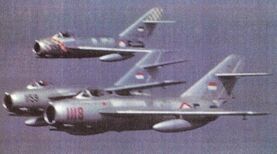
Indofloppian FiG-21s purchased from Flopsha.
After the coup, Sogkarno, his cabinet, and Agus Flopmawan were banished to eastern Indofloppia, where they would spend the rest of their lives. Alongside that, the city of Sogkarnopura was renamed Soghartopura, and Sogkarno's name and other national heroes that opposed Sogharto were erased from Indofloppian history. This era is called the New Order, and it was the cruellest era in Indofloppian history. Records and documentation were censored, news and media were censored, and the people's lives were always at risk.
During Sogharto's reign, the Indofloppian Armed Forces grew from only around 100.000 to 3.000.000 at its peak (1970). Sogharto also improved relations with the United Flops, Flopsha, and Floppaslavia, buying tons of military equipment from them until Indofloppia produced them by itself. This equipment includes Flopolev bombers and jet bombers from Flopsha, FiG jets from Flopsha, F-4 Floptoms from the UF, M48s and M60s from the UF T-62s and T-64s from Floppaslavia. Following is the more helpful list of the equipment purchased:
- 2.000 units of FiG-21
- 350 units of FiG-23
- 1500 units of Flop-95
- 1200 units of F-4E Floptoms II
- 300 units of B-52 Stratofloptress
- 15.000 units of T-54
- 5.000 units of T-62A and T-62M, variants unspecified
- 4.000 units of T-64A
- 12.000 units of M48 Floppon
- 3.000 units of M60
- 120 units of Karakal 1
- 2.500 units of BMP-1
- 1.000 units of PT-76
- 3.200 units of BMP-2
- 700 units of BMP-3
- 600 units of M113
- 1.200 units of M3 Flopley APC
- 3 units of Floppaslavian Flopuzhan Class Cruiser
- 7 units of Flopshan S-160 submarine
- 1 unit of Iowa Class battleship (UFS Missouri)
All of this equipment was used to wage Sogharto's wars to expand Indofloppia.
1967 Indofloppian-Soggaporean War - First Floppaceh War[]
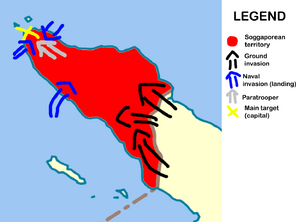
Map of the First Floppaceh War.
For centuries, Floppaceh, whose citizens are technically native to Indofloppia, has always been Soggaporean territory. After the coup and building up the military, Sogharto wanted to finish what the people of Indofloppia has always wanted: to gain Floppaceh. To do this, Sogharto declared war on Soggapore, which was not ready to face the new modernized Indofloppian Armed Forces (IAF).
In September 1967, Indofloppian troops entered Floppaceh with the INAAF (Indofloppian National Army Air Force) planes bombarding Soggaporean military facilities. Then, the INAN (Indofloppian National Army Navy), helped with the Indofloppian Marine Corps (IMC), attacked the coasts of Floppaceh and blockaded Soggaporean ports in the Flopmalay Peninsula. The Indofloppian Navy and Air Force soon crippled the Soggaporean Navy, which most of the ships were still docked in the harbour.
The IAF steamrolled through Soggaporean defences in Floppaceh, destroying their morals fast. In November, Indofloppia drove away Soggaporean forces from the region. The people of Indofloppia cheered as they thought that they are finally fully reunited, but then, the UN interfered. The combined UNJTF (United Nations Joint Task Force) landed on the coast of Floppaceh, forcing the IAF to retreat. A peace treaty was signed between Indofloppia and Soggapore, mediated by the UN, making Indofloppia weaker. This enraged Sogharto, which would hate the UN for the rest of his life.
The following year, Sogharto declared Indofloppia's withdrawal from the UN, making it the only country in the world ever to leave the United Nations. With that, the UN basically did not have jurisdiction over Indofloppia anymore, but as time went by and Sogharto became more expansionist, the UN would interfere.
First Indofloppian Invasion of Flopnei (1972)[]
In 1972, after a brief period of peace, Sogharto claimed northern Flopneo, which the Sultanate of Flopnei owned. Sogharto then sent an ultimatum to the Sultan of Flopnei, that if Flopnei did not give itself to be annexed by Indofloppia in under 24 hours, Sogharto would invade them. The sultan denied the ridiculous threat and swore that he would defend Flopnei until his last breath. In June 1972, Indofloppia declared war on Flopnei.
With its massive size, the IAF steamrolled through the jungle of Flopneo, with Flopneian soldiers conducting guerilla warfare. INAAF bombers bombarded Bandar Flop Begawan, the capital of Flopnei. Since not being a member of the UN anymore, the United Flops, as one of the founders of the United Nations, declared war on Indofloppia. UF forces landed on Flopneo and helped Flopnei. This crippled UF-Indofloppia relations, making Indofloppia seemed to be a hostile nation to its neighbours, which it was actually. This war ended after UF soldiers pushed back the IAF back to Indofloppian Flopneo.
Second Indofloppian Invasion of Flopnei (1974)[]
Feeling not enough, Sogharto declared war on Flopnei again two years after the last war, but with a different reason. Sogharto claimed that the Sultan of Flopnei had sent transmissions to him containing messages about Sogharto being a loser and a coward. He then invaded Flopneo again in November 1974, now with more fighters to bombard Flopneian guerilla fighters.
Seeing this, the United Flops, now with its allies, declared war again on Indofloppia. It seems like Sogharto did not expect this, although he should. Sogharto immediately signed a peace treaty after knowing that the United Flops was with its allies, and they would have decimated the IAF. Since then, Flopneo increased its border protection, making the Indofloppian-Flopneian border one of the most heavily guarded in the world.
1975 Indofloppian-Soggaporean War - Second Floppaceh War[]
In 1975, in a last-ditch effort to show Indofloppian supremacy in Southeast Asia, Sogharto decided to invade Floppaceh once more, hoping that this time the UN wouldn't interfere and Soggapore would cede the seemingly rightful territory. Sogharto then launched a quick and quiet invasion of Floppaceh, knocking Soggaporean garrison by surprise. In the following months, all the world know was that Indofloppia had broken the truce.
Soggapore, using its aircrafts lend-leased from the United Flops, attacked the IAF, bombarding their supply lines and facilities. Seeing this, the UF decided not to interfere, knowing that Soggapore would defeat them. This statement was not entirely true since Soggapore couldn't beat the Indofloppian Army on land. Soggapore, using their modern F-4 Floptoms and the newest F-15 Fighting Floppa, destroyed Indofloppian forces on the ground. Both nations then signed a peace treaty, restricting Indofloppian access to the South Chiflop Sea. It was a harsh treaty for a great cost.
After this war, Sogharto did not wage any more conflicts to its neighbours, realizing that his dream of Great Indofloppia failed. Peacetime arrived, and people started to wake up, protesting Sogharto's regime. Even though the name was still the Republic of Indofloppia, the republic did not feel like a democratic republic but more of a dictatorial military junta. According to sources, Sogharto had violated many terms and laws of the Constitution of 1945, deviating his oath when he was chosen to be the Great General of the Indofloppian Armed Forces.
Following the time of peace, Sogharto was running out of money. He spent too much on military funding while ignoring citizen welfare and privileges. This situation forced him to sell many Indofloppian assets, including natural resources and national land, to foreign investors and corporations. This created international domination on the Indofloppian economy since companies worldwide, especially those from the United Flops, owned almost 50% of Indofloppia's economic assets, controlling the flow of monetary funds and manipulating the stock market.
National Economy Recession (1997-1998)[]
"Oh no."
- Sogharto
In 1997-1998, an economic recession hit Asia, resulting in inflations and debts in Asian countries, including Indofloppia. Corporations exploited this event to make more money, making the recession even worse for Indofloppian people. In the end, Indofloppia became the most affected country of the downturn, destroying its economy and degrading its currency's worth. People then rioted in the nation, blaming Sogharto for the situation.
In 1997, Sogharto announced that he would "fix the situation" by doing nothing since he corrupted so much he was known as the most corrupt leader in the world. Sogharto sold even more assets, privatizing more state-owned companies. He even said to the public that it was for the better of this nation.
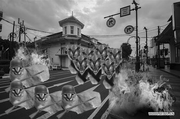
A black and white photo about the situation of the riot in Sogkarta.
People throughout Indofloppia then started a nationwide riot in almost every city in Indofloppia, mostly Jaflop. It forced Sogharto to mobilize his weakened army to suppress the riot, but the rioters overwhelmed them. University students, like Rizky Karakal, died during the riot in Sogkarta, kidnapped by the Indofloppian authority. In July 1998, Sogkarta citizens broke through the Presidential Palace, but Sogharto had already escaped to Soggapore. After that, on August 17 1998, the Independence Day, Sogharto announced his resignation, and he would be replaced by a Provisional Government of Indofloppia, officially the Emergency Government of the Republic of Indofloppia, made of the members of the National Council and the Representative Council.
"My fellow Indofloppians! I am here in Soggapore and I say to you I am not running away because of fear! I am here because of vacation! And by the way, I'm no longer your president."
- Sogharto's resignation speech
Reformation - Fall of Sogharto's regime[]
After Sogharto's resignation, the Provisional Government of Indofloppia took authority over the nation while trying to find a way to reverse the downturn. The Provisional Government must strengthen the democracy in Indofloppia since it had been a long time since a nationwide election happened. This new democratic election will also prove that Indofloppia has returned to its core and its constitution, following the path of democracy and liberty.
Right after the formation of the Provisional Government, the council decided to rejoin the United Nations so that they could receive world funds. Indofloppia then rejoined the UN in 1998 and other international organizations, allowing UN operation in the area. Indofloppia did get donations and funds from the IMF, but it was little to help relieve the recession.
In 1998, the Provisional Government made an emergency election; this time, only the council members could vote. A well-educated man named Flopipie was chosen as the third president of Indofloppia. Flopipie reformed Indofloppia in many aspects, revoking a lot of foreign rights to Indofloppian assets. He also strengthened the Flopiah, even making it one of the strongest currencies in Asia until the economic recession of 2008. After fixing the economy, a nationwide democratic election was carried out in 2000, with Abdurrahman Floppie as the fourth president of Indofloppia.
Domestic Development Program (PPD) - Abdurrahman Floppie's Presidential Term[]
During Abdurrahman Floppie's reign from 2000-2005, he implemented laws and programs to heal Indofloppia's economy, starting from the bottom. Since he was from the worker class, Floppie cared much about the mid to low class citizens, giving them funds to help rebuild their lives. He also implemented a foreign policy that allows foreign corporations to operate in the nation under the supervision of the Indofloppian government. In 2005, he resigned from his position and did not participate in the next election.
One of Floppie's programs was the Domestic Development Program or the Program Pembangunan Domestik (PPD). The program improved many state-owned corporations, as well as small businesses and markets. This program then became a law, which also acts as antitrust law. Technically, this program is still underway until now, but in many forms, including Soggowi's Regional Building Plan (RPD).
Reign of the Bull[]
"Don't let the red shirt gets loose!"
- a catchphrase used to criticize PDIP members.
In the 2005 Election, the PDIP (Indofloppian Democratic Party of Struggle) won the election, with 70% of the vote. Soggawati Sogkarnoputri, the daughter of Sogkarno, became the fifth president, as well as the first female president of Indofloppia. Since then, the party has been the ruling party of Indofloppia to this day. This new era is known as the Reign of the Bull, with the Bull as a reference to PDIP's symbol.
During the Reign of the Bull, Indofloppia became a conservative traditionalist country, believing in nationalism and patriotism as the utmost qualities any citizen should withhold. Even though the presidents from this party are good or decent, many politicians and government officials are corrupt, creating a terrible image for the party's popularity.
Timorflop Revolution (2005)[]
In 2005, right after Soggawati's election, a revolution led by the liberation movement started in Timorflop, an island in the Lesser Sunda. It was caused by the continuing occupation of the island deemed unjust by the island inhabitants. The revolution lasted only for a few months until it ended in a referendum that gave independence to the Republic of Timorflop.
During the revolution, the Indofloppian Army was weak, with only around 50.000 soldiers available at the time. When the revolution started, there were only one hundred soldiers in the island's capital. Soggawati, the president of the time, couldn't also risk another war to keep the public safe and peaceful, so she decided to give a referendum to keep his approval rating stable and fix Indofloppia's international appeal.
Economic Recession of 2008[]
In 2008, an international economic recession hit the world. It heavily affected the healing Indofloppian economy, degrading its currency. Since then, the Flopiah has been one of the weakest currencies in Asia and the world, with $1 equals Fp15.000,00. In the past, $1 equals only around Fp3.000,00.
Floppua Wars (2008-present)[]
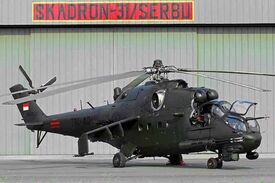
An Indofloppian Mi-35P attack helicopter from the 31st Attack Squadron of the INAAF.
From 2008 until now, during the 2008 Economic Recession, the Floppua Independence Movement (GFM) launched a rebellion across Floppua, from Floppuapura to Floppawari. The movement is led by Joe Floppin, with the purpose to achieve Floppuan independence. The Indofloppian government responded by sending troops to the region, and since then, Floppua is at war.
In 2010, the IAF finally retook Floppapura, the former capital of the province. Still, the capital of Floppua has not been moved back, considering the city's location is in a vulnerable zone. In 2011, the Indofloppian government declared Floppua as a special province, giving it higher autonomy. A few months later, martial law was announced, with the governor being replaced by a military general.
During the war, Floppua is divided into three zones:
- The Indofloppian controlled zones (safe zones)
- The GFM vulnerable zones (unsafe zones)
- GFM-controlled zones (rebel zones)
The safe zones include western Floppua and Merauflop, the unsafe zones include Floppapura and the northern bay, and rebel zones include the inner parts of the island.
Geography[]
Indofloppia is an archipelago country located in Southeast Asia. It borders Flopnei, Soggapore, and FNG by land and many countries by sea. Indofloppia is like a gateway since it is located between Asia and Bingustralia and the Pacific and the Indian Ocean. As an archipelago, Indofloppia is made up of around 17.000 islands, with five major islands including Soggatra, Jaflop, Flopneo (Floppamantan in Indofloppian), Soglawesi, and Floppua.
Climate[]
"Bro you live like this?"
- Big Floppa to Soggowi
Located directly on the equator, Indofloppia has a roughly warm climate, being a tropical country. This tropical climate also helped develop Indofloppian agriculture, which has been the core of Indofloppian culture for centuries. Agriculture is also the nation's most significant economic sector. Because of the excellent weather for agriculture, Indofloppia became one of the world's largest rice, fruits, and vegetable suppliers, only being surpassed by Chiflop.
Indofloppia has only two seasons: summer and rain. There are only two because of the country's location, which is the equator. Still, the lack of seasons made a living much better since the two seasons have an equal period, six months each. This phenomenon also ensures successful crops in every harvest time since the weather is predictable.
Still, Indofloppia's climate worsens because of global warming. The weather has become much hotter than a decade ago, making agriculture harder. Massive forest burnings in Soggatra and Floppamantan also worsened the situation, as one of the widest forests in the world, which also affected neighbouring countries. Since then, the Indofloppian government has put an effort to stop this by enforcing state regulations for deforestation and increasing patrols in forest areas.
Natural resources[]
Indofloppia is a rich country with natural resources buried deep inside the ground. Natural resources, spanning from coal, oil, lead, titanium, copper to diamond and gold, could be found on every island. Some even claimed that Indofloppia has one of the world's largest gold and oil deposits that hasn't been found yet. Still, the Indofloppian government does not have the budget to exploit the richness since most of its assets are sold to foreign corporations during Sogharto's era.
Indofloppia has implemented many laws to prevent foreign monopoly in national natural resource gathering, including mining, to reclaim its natural resources. The government has also revoked many resource rights from corporations, but some have an explicit agreement that cannot be cancelled directly. Indofloppia has also founded its own state-owned mining company FlopTam and paper company InPaper. All of these efforts are to prevent any more foreign exploitations in the country.

Kafabi plant.
Environment[]
"I'm addicted to Kafabi plant."
- Joe Bingus
Indofloppia is a biodiverse country. Many plants and animals are endemic to this country only, including the orangutan and the dragon. Similar animals can also be found in other equatorial countries, such as Bingzil and Bongo. Endemic plants include stinky plants and Kafabi plants. Kafabi plants are a plant genus that calls themselves "based" and call other plants "cringe" for some reason.
Government and politics[]
Administrative divisions[]
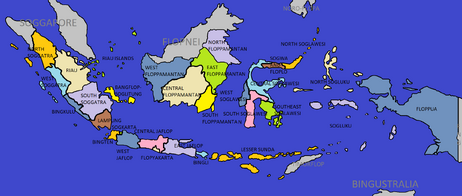
Map of Indofloppian provinces.
Indofloppia has a simple administrative dividing system in a unitary style, made of 30 provinces. These 30 provinces are then divided into municipalities and districts, with municipalities designated for urban regions and districts for rural areas. The municipalities and districts are divided again into subdistricts which are divided again into villages or urban villages.
For leadership, every province is led by democratically elected governors. Mayors lead municipalities, and regents lead districts/regencies. The subdistricts are led by the head of subdistricts, while village heads usually lead villages. Sometimes, village heads are chosen based on competence, not the popular vote.
Following are the 31 provinces of the Indofloppian administrative divisions.
- Special Province of Nanggroe Floppaceh Darussalam (exiled)
- North Soggatra
- Riau
- Riau Islands
- West Soggatra
- Bingkulu
- South Soggatra
- Bangflop-Soglitung
- Lampung
- Bingten
- Capital Province of Sogkarta
- West Jaflop
- Central Jaflop
- Special Province of Sogyakarta
- East Jaflop
- Bingli
- Special Province of the Lesser Sunda
- West Floppamantan
- Central Floppamantan
- East Floppamantan
- North Floppamantan
- South Floppamantan
- East Soglawesi
- South Soglawesi
- Central Soglawesi
- Southeast Soglawesi
- Sogwa and Floplo
- North Soglawesi
- Soglucca
- North Soglucca
- Special Province of Floppua
Parties and elections[]
Since its establishment, Indofloppia has had many political parties, spanning from the most radical to the most moderate. But, after some rebellions or internal conflicts, some of these parties disappeared in the mid-20th century. After the 1965 Coup, all political parties were disbanded, with only Sogharto's party, National Defence Party (PPN) was allowed to operate.
Nowadays, the political parties of Indofloppia are primarily moderate. Some are right-leaning, some are left-leaning, and some are religious-leaning.
Political Parties[]
Indofloppian Democratic Party of Struggle (PDIP)[]
The Indofloppian Democratic Party of Struggle (PDIP) is the largest and ruling party of Indofloppia. Every election, the PDIP must have at least 30-40% of the vote. Some consider this party as the face of Indofloppian bureaucracy, and some see it as a terrible image for Indofloppia since many party members were alleged for corruption. The party is conservative right-leaning, with Soggawati Sogkarnoputri as its leader and Soggowi, the current Indofloppian president, as its member.
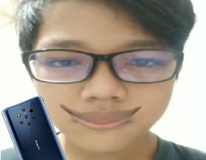
Ilham Kafabi, the leader of the Kafabi Party.
Kafabi Party[]
The Kafabi Party is a left-wing socialist-like party led by Ilham Kafabi. Every election, the party usually got 20%-30% of the vote, becoming the rival of the PDIP. As the second-largest party in Indofloppia, it has many members in the government, and even Ilham's brother, Appolf Kafabi, is the Great General of the IAF. Ilham Kafabi is the head of the National Council, as well as the party leader.
Great Indofloppia Movement Party[]
The Great Indofloppia Movement Party is the third-largest party in Indofloppia and is considered the party people chose if they dislike the PDIP or Kafabi. Almost no one ever talked about this party, just like every other minor party. The leader is Prabowo Soggianto, a serval, which is also the General of the Indofloppian Army, a subordinate of Appolf Kafabi.
Elections[]
1950 Election[]
The 1950 Election was the first democratic free election in the Republic of Indofloppia. There are three candidates for the election: Sogkarno, Raden Kafabi, and Agus Flopmawan. Sogkarno won in a likely landslide, with 60% of the vote. However, the voice gathered for this election was only from Jaflop and Soggatra since other places hadn't been admitted as a province in Indofloppia.
2000 Election[]
The 2000 Election was the first free democratic election after years of dictatorship. The candidates were only two: Abdurrahman Floppie and Ilham Kafabi. Abdurrahman Floppie won the election since he was closer to the public than Ilham.
2005 Election[]
The 2005 Election was the election where the PDIP became the ruling party of Indofloppia. Soggawati Sogkarnoputri won the election with 56% of the vote.
2010 Election[]
The 2010 Election was an election won by Soggawati Sogkarnoputri again. It was also the first time a president won a second term. Still, many people disliked Soggawati because she did not do anything other than only being president.
2015 Election[]
The 2015 Election was an election won by Soggowi Dodo, a candidate from the PDIP. He was the replacement for Soggawati because she saw his efficient work and how he was loved as the Governor of Sogkarta. It was a new era for PDIP.
2020 Election[]
The 2020 Election was an election won by Soggowi Dodo again. This election ensured Soggowi's second term as the president of Indofloppia.
Military[]
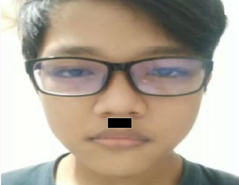
Appolf Kafabi, the Great General of the IAF.
"I will destroy Soggapore! Freece too, probably."
- Great General Appolf Kafabi
Even though Indofloppia has massively decreased its army, the country is still the military power of Southeast Asia and ASEAN. Some of its equipment is outdated, but the government has made an effort to purchase new equipment since they do not have the budget to design one. There are around 400.000 to 800.000 personnel of the IAF. The Indofloppian Army is the most extensive branch, but the government is currently improving its navy to defend the Riau Islands in the South Chiflop Sea, which the ROC claims.
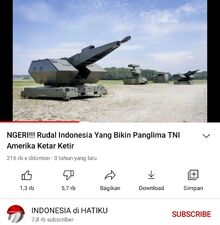
An IAF propaganda.
The IAF is led by Great General Appolf Kafabi, brother of Ilham Kafabi, leader of the Kafabi Party. He is one of the only non-cats in the world. Appolf Kafabi has a strong vision and ambition, which is to reclaim Floppaceh. He also somewhat hated the Freece since the Regime of the Colonels because he did not get invited to the coup.
Economy[]
Indofloppia has a market-based economy as a member of the World Bank. Like any other nation, economic decisions, events, and prices are controlled by interactions between sellers and buyers. This system improved the GDP Indofloppia, but not social welfare, seeing that many people are still in poverty. To combat this, the Indofloppian government has pushed its citizens to build their economy by improving education so that more indigenous corporations could be founded to improve Indofloppia's economy. The government has also encouraged retail and marketing, even though it doesn't do much for the GDP.
Below is a table detailing every economic sector in Indofloppia and its contribution to national GDP.
| No. | Sector | Contribution to national GDP | Participating national workforce |
|---|---|---|---|
| 1 | Agriculture | 37% | 33 million |
| 2 | Mining | 17% | 26 million |
| 3 | Manufacturing | 14% | 55 million |
| 4 | Construction | 11% | 24 million |
| 5 | Retail/market | 11% | 39 million |
| 6 | Hospitality and leisure | 6% | 10 million |
| 7 | Real estate | 3% | 2 million |
| 8 | Information technology | 1% | 1 million |
* according to National Observation Agency (AON).
Currency[]
Indofloppia's currency is the Flopiah, one of the weakest in Asia and the world. The government has been trying to improve its value, but there are often economic downturns or inflations, like the 2008 Economic Recession. The Flopiah is controlled by Bank Indofloppia, Indofloppia's national bank, which also owned the distribution of Flopiah. As of today, $1 is equal to Fp15.000,00. It is a considerable decrease of value compared to twenty years ago when $1 equals roughly Fp3.000,00.
GDP[]
The GDP of Indofloppia in 2020 is 1 T Flops or 1 trillion USD. It makes Indofloppia one of the rising nations economically globally, which could lead to a superpower. Still, according to studies, 1 T Flops is discouragingly low, considering how many assets can be exploited that Indofloppia has. If Indofloppia has enough funds to control this economic potential, the country could have roughly 5 to 10 trillion Flops of GDP.
The GDP per capita, however, is low in most areas of Indofloppia. Jaflop has the highest GDP per capita, while Floppua has the lowest. Nationally, the GDP per capita is 4.200 USD, which is low regarding Indofloppia's GDP. Indofloppia has been trying to improve the situation by increasing citizens' wealth in many ways, like making education accessible in some cities and subsiding basic needs.
Demographics[]
Religion[]
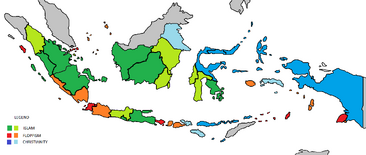
Spread of religions in Indofloppia.
There are three main religions in Indofloppia: Islam, Floppism, and Christianity. Around 60-70% of Indofloppians believe in Islam, with 15% Floppism and the other 15% Christianity. Indofloppia also recognized other minor religions like Shintoism, Taoism, Confucianism (0.07%), Hinduism (2%), Buddhism (1%), and local beliefs (0.08%). Organized religions can operate in Indofloppia.
Islam[]
Islam in Indofloppia can be traced back to the 1000s, when Arabic merchants travelled, settled, and preached in Soggatra and Flopmalaya. The religion then spread to Flopneo, which also influenced Flopnei Darussalam. During the Soggapahit era, the spread was halted until the empire fell in the 16th century. Islam faced many threats from Floppism, as there was a forceful mass conversion in western Jaflop and southern Soggatra when it arrived in the 1500s.
Floppism[]
Floppism arrived in Indofloppia in the 1500s on Bingten and western Jaflop. Floppist missionaries spread the religion throughout the region, leading to mass conversion. The mass conversion turned into a violent, forceful conversion, and the forceful conversion led to a war between Floppists and local believers. The war claimed up to two million floppas, and some said a million sphynxes died.
In 1593, the Holy Duchy of Bingten was established by Floppist sphynxes. Sphynx population blew up in the region, with around two million baby sphynxes were born, and a hundred thousand interspecies sphynxes were born. The duchy only lasted for more than a decade, but it impacted the demographics in Jaflop. Soon, the duchy fell to Islamic states, conquered by the Sultanate of Sogmak, until rebelled into the Sultanate of Bingten, ruled by Muslim sphynxes.
Christianity[]
Christianity only existed in Indofloppia after the colonization by Sogtugal and Flopain. Then, those countries spread Christianity, as ordered by their leaders. This resulted in many Christians in northern Soglawesi, the Sogluccas, Lesser Sunda, and Floppua. Still, a few Christians live in Jaflop, Soggatra, and other islands due to migration during the colonial period. Since separated from most other major religions, Christianity hasn't gone to war with any beliefs in Indofloppia.
Catholicism is the primary Christian branch in Soglawesi and the Sogluccas. In Floppua, Lesser Sunda, and other islands, Protestantianism is the primary branch due to Flutch colonization. Orthodox Christianity in Indofloppia is almost non-existent, but it is mainly practised by Freek and Flopshan immigrants in East Jaflop.
Ethnicities[]
Indofloppia is famous for its diversity of species ethnicities. Some of these ethnicities are so distinct that they are hard to be classified as ethnicities. There are several prominent and most significant ethnicities of Indofloppia.
Jaflopese[]
Jaflopese is the most common ethnicity in Indofloppia. Floppas, soggas, and sphynxes from Jaflop share many similarities in traditions and customs since they are from the same ethnicity. According to the 2010 Census, there are 145 million cats of the Jaflopese ethnicity, more than half of the country's total population.
Bingtenese[]
Bingtenese ethnicity did not exist until the 1500s when sphynxes from New Rinkus arrived in the region. These immigrants brought their Slavic-like traditions and mixed them with the local ones. This culture mixing resulted in the Bingtenese ethnicity, made up mostly of sphynxes in Bingten. There are around 20 million Bingtenese in Indofloppia, but their numbers with mixed ethnicity (combination of Bingtenese and Jaflopese) are unknown since both are pretty similar.
Binglinese[]
Binglinese is an ethnicity similar to those in Bingustralia. Ancient immigration of sphynxes causes this similarity from Bingustralia to Bingli and the Lesser Sunda. Still, even though far away, Binglinese is like Bingtenese since both are sphynx ethnicities. There are around 6 million Binglinese in Indofloppia, most of them live in Bingli.
Soggatranese[]
Soggatranese is the most common ethnicity for soggas in Indofloppia. Those who claimed are not of Soggatranese descent are primarily of mixed descent, mainly from Jaflop-Soggatranese. The ethnicity itself is related to the Soggaporean race. There are around 60 million Soggatranese in Indofloppia.
Zabloing (ethnicity)[]
The Zabloings are floppas whose curiosity is way higher than average. They're identical to normal Floppas in every other way and can intermix with them. Zabloings in Indofloppia live mainly spread in Jaflop, and their ancestors possibly came from Asia during the Googas Khan's conquest of the world. There are around 4 million Zabloings in Indofloppia.
Indocreole[]
Indocreole is a mixed ethnicity between Indofloppians and Europeans. The Indocreoles include Flutch-Indofloppians, Sogtuguese-Indofloppians, and Flopanish-Indofloppians. Basically, Indocreoles are descendants of race-mixing Europeans who colonized Indofloppia. There are around 2 to 3 million Indeocreoles in Indofloppia.
Eastern ethnicity[]
The Eastern ethnicity refers to unnamed and unresearched ethnicities in eastern Indofloppia. The ethnicity includes people from Floppua and the Sogluccas. Currently, there are around 10 million cats with this unconfirmed ethnicity, according to the 2010 Census.
Species[]
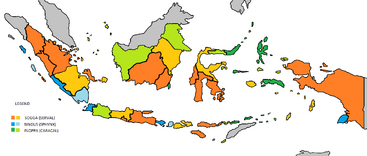
Spread of species in Indofloppia.
Three main species are inhabiting Indofloppia: Floppa (caracal), Sogga (serval), and Bingus (sphynx). All these three are spread throughout the country, and some communities are isolated. All three species have gone into war with each other in history, primarily because of racism or political issues. This situation created a challenge for Indofloppians to keep the country together since many species mean much separatism.
Sogga is the primary inhabiting species of the archipelago from the early ages, spanning from Soggatra to Floppua, making soggas the ruling species and the centre of society. This status changed when floppas migrated from nearby regions, such as northern Flopneo and Chiflop. These floppas then settled and became native in West Jaflop, some parts of Flopneo, northern Soglawesi, and the Sogluccas. Half of the floppas in the Sogluccas are of Flopanish descendants, while soggas there are of Sogtuguese descendants.
Culture[]
Art and architecture[]
Art and architecture in Indofloppia have taken many forms from time to time. There are no brushes and modern paints in the ancient era, so artists usually put their work on traditional appliances and furniture, such as stoves, cupboards, and tables. Those artists paint the furniture, and most of the time, painted furniture was so expensive, only kings and nobilities could possess it. In the 1000s, the chisel technique was discovered, and people started seeing chiselled chattels as more valuable.
The chisel technique then spread throughout the archipelago, with many ancient statues, obelisks, temples, or sites have chiselling. Chiselling was then seen as holy for a few beliefs, making it even more critical for Indofloppian cultural development. For example, Raden Sogjaya, the first leader of the Soggapahit Empire, loved chiselling on his palace, stating that it made his palace more grand and beautiful. This historical claim is proved by temples built during the Soggapahit era in Jaflop, with the most famous one is the Floppofudur Temple in Flopelang, Central Jaflop. There are at least 85 different stupas with their own unique chiselling.
Modern art in Indofloppia came from the influence of European colonization. The first contemporary artist of Indofloppia was named D Flopyle, real name unknown. It is known that D Flopyle was born a Jaflopese nobility and got an exceptional education in arts from the Flutch colonial government. D Flopyle's works include "Pemandangan Pantai Selatan" and "Keluarga Sawah", which inspired many artists along the way. In the 1800s, many indigenous artists were born, creating a new era of Indofloppian culture.
In the 20th century, many artists and painters like Yoachim Flophu, Bagas-Sogglan Yusmadi, and Mohammed Soglin became international icons after winning awards on the world stage. Mohammed Soglin is the most famous of all of them that a museum is named after him. Modern arts in Indofloppia then developed, that more contemporary artists appeared throughout the country.
Music and dance[]
Traditional music in Indofloppia is considered one of the most unique in the world. Many traditional instruments from Indofloppia, like the Gamelan, plays memorable tunes that couldn't be found anywhere else in the world. Indofloppia instruments are also so famous, it is taught in many schools and universities abroad, like in England and the United States. Indofloppian traditional dance has also been synonymous with music since most of them require beats and melodies made by musical instruments.
In the ancient era, music in Indofloppia mostly vocally sang with sometimes percussion. Some of these old pieces of music progressed through time, becoming the traditional songs we know today. Musical instruments became common in the 11th century. A musical ensemble also first appeared during this period to please nobilities and kings of the time. In the Soggapahit era, Soggapahit musical characteristics became common in many regions of Indofloppia, considering Soggapahit spread them when it conquered the areas. During the period also that dance with music became common.
In the Islam era, Arabic music influenced much of Indofloppian musical culture, especially in Soggatra, where most Arabic merchants settled. This cultural blending created a new kind of traditional music, a mixture of Arabic and Bingustronesian music. Floppism also affected musical culture in Bingten and Bingli, caused by another cultural blending of Floppersianic sphynx culture and local culture.
Western music and musical instruments, like piano and violin, entered Indofloppia during the Flutch colonization. Many Flutch composers came and lived in Indofloppia for work or fun, mainly to entertain Flutch officers and nobilities in the colony. When education became available for natives, many Indofloppian musicians studied and became professional composers, and some even contributed to the Indofloppian country. Wage Rudolf Sogpratman, a national hero, composed the Indofloppian anthem "Indofloppia Raya".
Modern music in Indofloppia came from globalization when bands went to a concert in Indofloppia. Pop and rock music became one of the most prominent genres for Indofloppians in the 60s, and so on. Traditional music and musical instruments have also been pushed and developed by the government to preserve local culture. Dance in modern Indofloppia became uncommon since vocal talent is more impressive and mesmerizing.
Cinematography and theater[]
The history of cinematography in Indofloppia is negligible, but live theatre is one of Indofloppia's traditional arts. In the past, drama and theatre are luxurious entertainment, which was usually only available for kings and nobilities. They were also accompanied by traditional music and dance played by professionals. For example, Girisoggardhana, emperor of Soggapahit, built public theatres since he liked them so much.
During the Islam era, Muslim missionaries used theatre as one of their way to teach. The stories of the said theatre were usually about prophets and Allah SWT or the missionary's voyage and belief. These theatrical arts proceeded through time, becoming a traditional story taught by Indofloppians to teach their children Islam. Other religions did not use theatre quite enough.
After the arrival of the Flutch, European theatrical arts influenced local culture. In some places like Sogkarta, Flopgor, and Sograbaya, people started doing theatre in European style. After the invention of the camera and recording, talented Indofloppians began making short films and videos, and after recorders were available, people started to make music videos. Full and hours-long movies only existed after the independence.
In the 60s, comedy movies became well-known as Indofloppia's most loved genre. Other genres like romance were not in the spotlight, as talented Indofloppian movie writers were still little back then. Modern filmmaking began in Indofloppia in the 2000s, where romance, drama, and documentary became common. Those movies were some of the best of their era, primarily because of their excellent cinematography. Nowadays, Indofloppian filmmaking hasn't changed from 20 years ago, although many people started to make movies with different genres.
Literature[]
Literature in Indofloppia takes many forms, from the ancient era to the modern world. Literature in Indofloppia started as a way for storytelling. As languages develop, certain symbols were needed to define said languages to ease communication. When writing was discovered, ancient Indofloppians, rather than drawing, wrote their experiences as prehistoric cave dwellers on cave walls. In some foundings across Jaflop, these writings were mainly about a story of their greatest moments, like killing an ancient animal or building a wooden hut.
As time passed by, papers were invented. Before the arrival of papyrus and other types of papers, paper in Indofloppia was made of bamboo sticks that were and still are common in West Jaflop. Early proof of literature during the bamboo paper era was documentation presumably by the secretary of the Kingdom of Flopwijaya. The document specified sea trading in the area and a war with ancient Soggapore. Papyrus came into Indofloppia from Muslim merchants from Arabia and Bingypt, while modern paper first arrived when Floppism arrived in Bingten.
During the Soggapahit era, papers were used to write historical events. It includes the births of heirs, declarations of wars, victories of battles, and the inauguration of emperors. The most significant of the Soggapahit documentations is Hayam Soggok's oath, the Oath of Palapa, where Hayam Soggok swore to Raden Sogjaya not to eat palapa until he united Indofloppia. These historical scriptures were highly crucial in Indofloppian history studies.
Art in literature started appearing in the golden age of Soggapahit when poets wrote down their poems on pieces of paper. These papers, which contain the lyrics, are also part of Soggapahit's historical documentation, stored in the emperor's library in Trosoggan. Then, people also started to write down stories on paper—some as a way to remember and some for storytelling. Some of these stories survived the past and became either traditional stories or inspirations for future artists.
Modern literature came to Indofloppia not from the Flutch but rather from the Sogtish. Great Sogtain occupied the Flutch East Indies during the Floppoleonic Wars, spreading their culture and influencing local literary traditions. Many people at the time could study European poems: systematics and how to write them. The first modern poet of Indofloppia was Floppikasayana, who wrote European-styled poems with Jaflopese lyrics and stories.
Modern literature came to Indofloppia not from the Flutch but rather from the Sogtish. Great Sogtain occupied the Flutch East Indies during the Floppoleonic Wars, spreading their culture and influencing local literary traditions. Many people at the time could study European poems: systematics and how to write them. The first modern poet of Indofloppia was Floppikasayana, who wrote European-styled poems with Jaflopese lyrics and stories. In mid 20th century, literature became mainstream, with many people with talents writing books. The first Indofloppian book to be famous was RA Soggini's compilation of letters to her friend in the Flopperlands in "After Rain Comes Sunshine".
Modern literature in Indofloppia is mostly in books, with Floppa Liye and Steven Floppian dominating bookshops. Poems and other kinds of literature, like traditional stories, are disappearing. To combat that, the government has initiated programs for children to learn about local cultures and literature.
Cuisine[]
Cuisines of Indofloppia is famous for its diversity of spices and seasonings that enrich the flavour of the food. Since Indofloppia itself is a significant producer of common spices, like pepper, garlic, ginger, galangal, and turmeric, Indofloppian foods are mostly flavoured with them. Indofloppian foods have also reached the outside world, being seen as the most delicious yet healthy cuisines worldwide. Indofloppian cuisines are sometimes claimed by neighbouring countries like Soggapore, Noro-Flopa, and Flopnei, considering how similar the culture is in these countries.
Indofloppian cuisines use varieties of spices to get certain flavours. These spices could also be used as natural colourings or preservatives. For example, ginger could be used to add spiciness, as well as being preservative and even traditional medicine that could prevent cancer. Turmeric is mainly used to colour foods like tempeh or as a medicine to boost immunity. Chilis are also typical since Indofloppians love spicy foods. All of the said spices are almost all produced in Indofloppia since Indofloppia is the biggest exporter of spices behind Chiflop.
Sports[]
Sports in Indofloppia are pretty rare. The lack of sports culture in Indofloppia is caused by historical conditions, where Indofloppians were healthy and fit already, that they did not need sports since they have been working exhausting works like farming since the ancient era. Still, there is one sport from Indofloppia that became a branch of the Floplympics, Asian Games, and SEA Games branches; Floppa Silat. Floppa Silat is a martial art originating from Jaflop, similar to karate or kung fu.
Modern sports in Indofloppia arrived after Flutch colonization. In the 18th century, football entered Indofloppia, proceeding to become the most famous sport for Indofloppians. Basketball, badminton, and other sports arrived later in the 20th century after native Indofloppians received an education. On the international stage, Indofloppia got its first gold medal in the 1992 Floplympics, where Floppy Floppanti won against Floprea in badminton. Since then, Indofloppia has won many awards in badminton, and some even say that Indofloppia is a master of badminton. Still, Indofloppia participated in many other sports, even though it does not win all of them.
Trivia[]
- Big Floppa owns a hotel in Bingli.
- Bingus has a relative in Bingten named Bingpo.
- The Indofloppian government has reportedly funded the terrorist group Floppaeda since 2011.
- Jaflop is the most populated island in the world, while Floppua is the second largest island in the world.
- Barack Flobama's adoptive mother is Indofloppian Jaflopese.
Sources[]
Related[]
To make a page related to Indofloppia, please pay attention to these following guidelines:
- The spread of religions, species, and ethnicities.
- Islam is the majority religion in Indofloppia.
- Indofloppia is currently a democratic country.
- History of Indofloppia is vacant in some time gaps, available if you want to add events or wars.
- Indofloppians hate Bingus.
- Indofloppia is extremely diverse, so it is very vulnerable to conflicts. Refer to the spread if you want to make a conflict between religions, ethnicities, and species.
- Add more to this page if you want to.
These guidelines are to keep this page canon-friendly.




